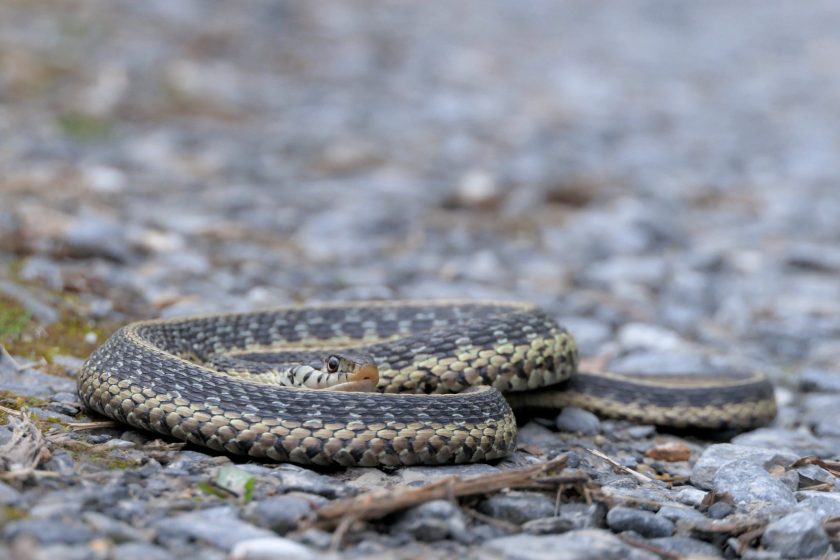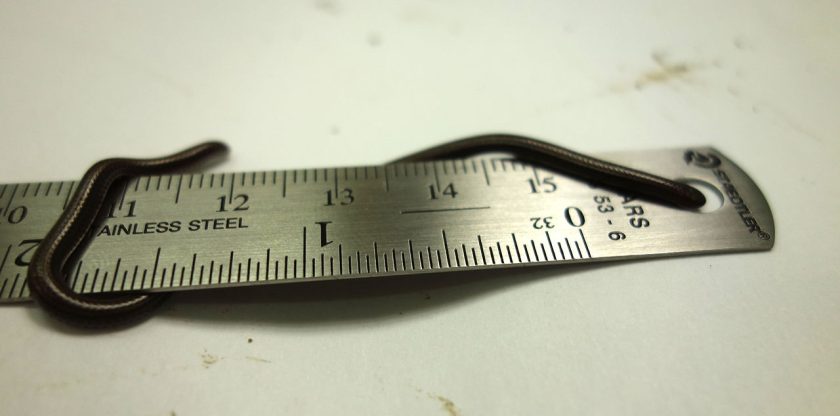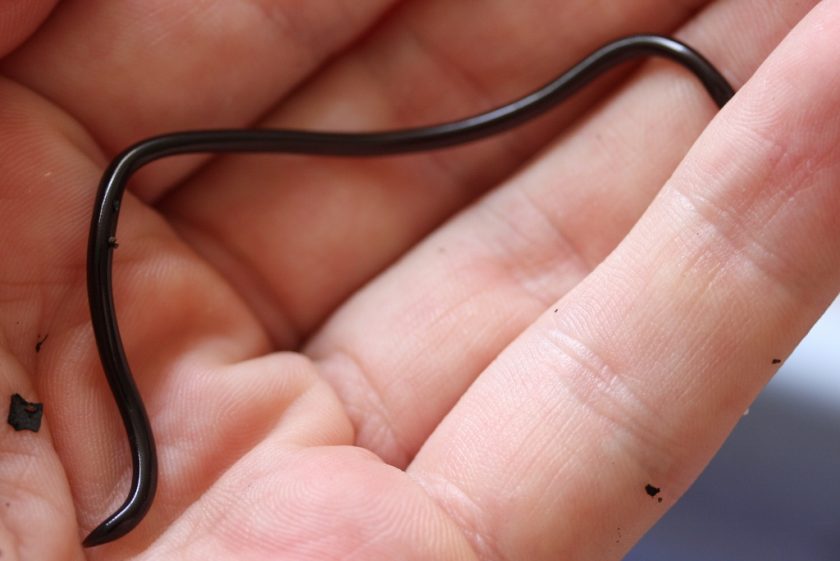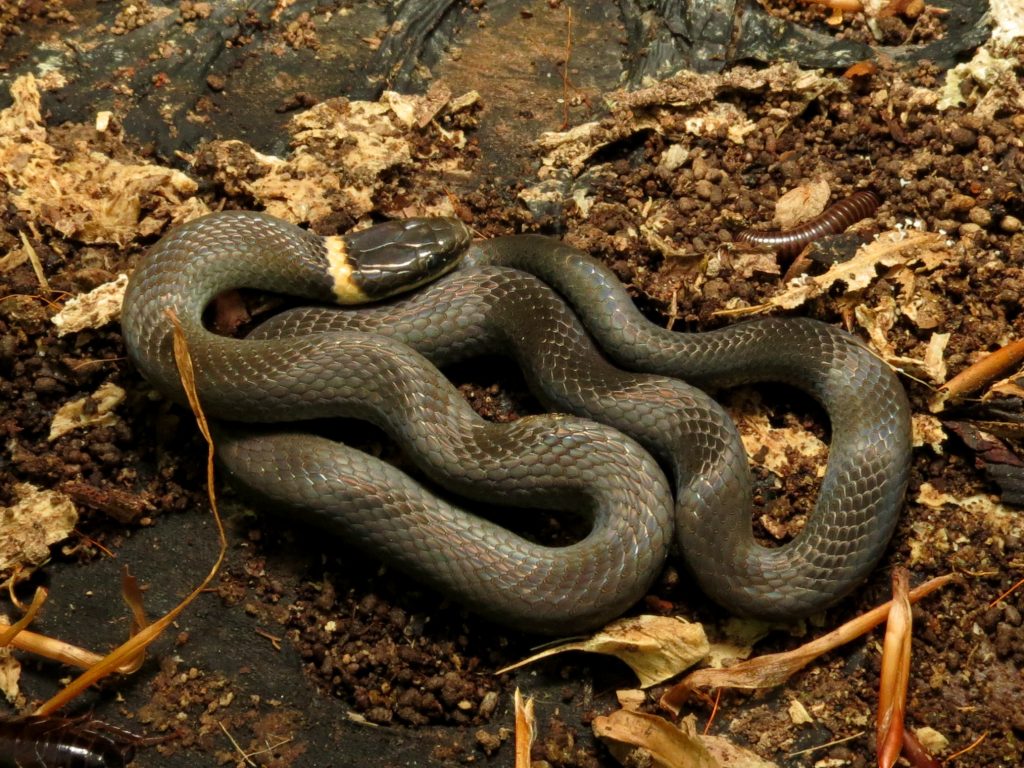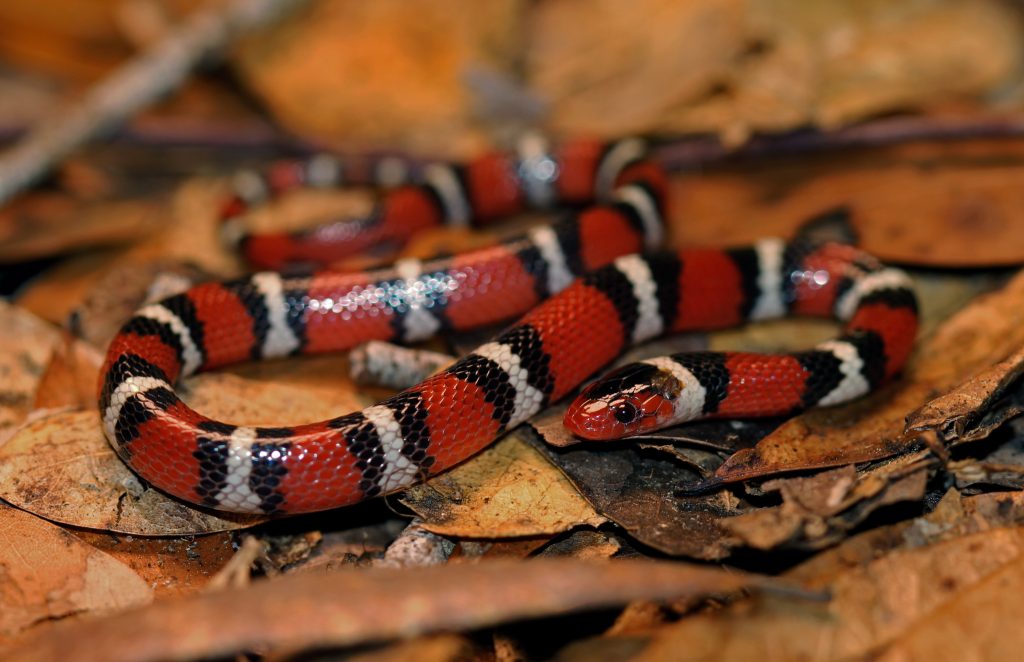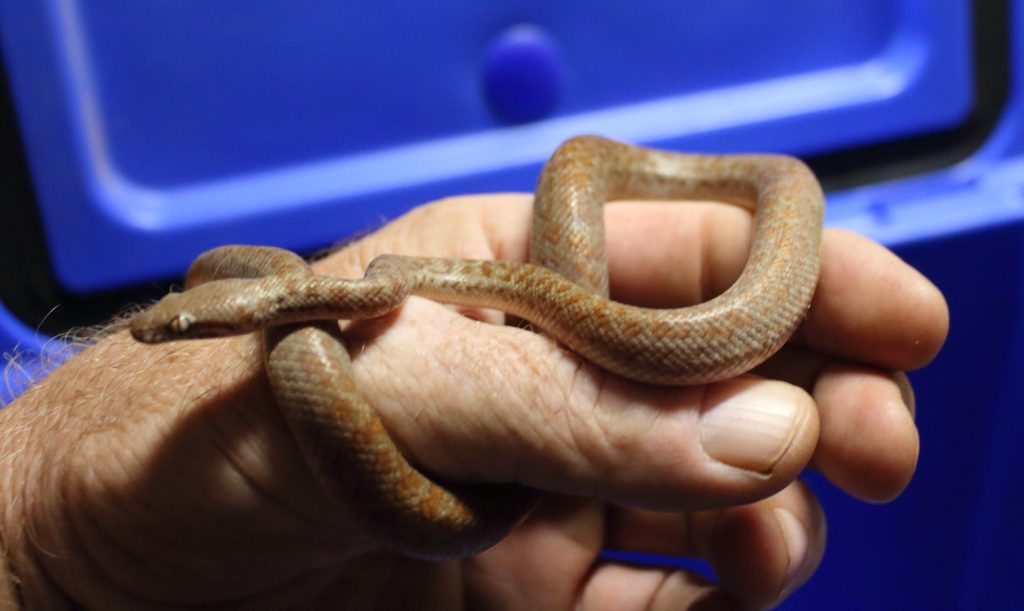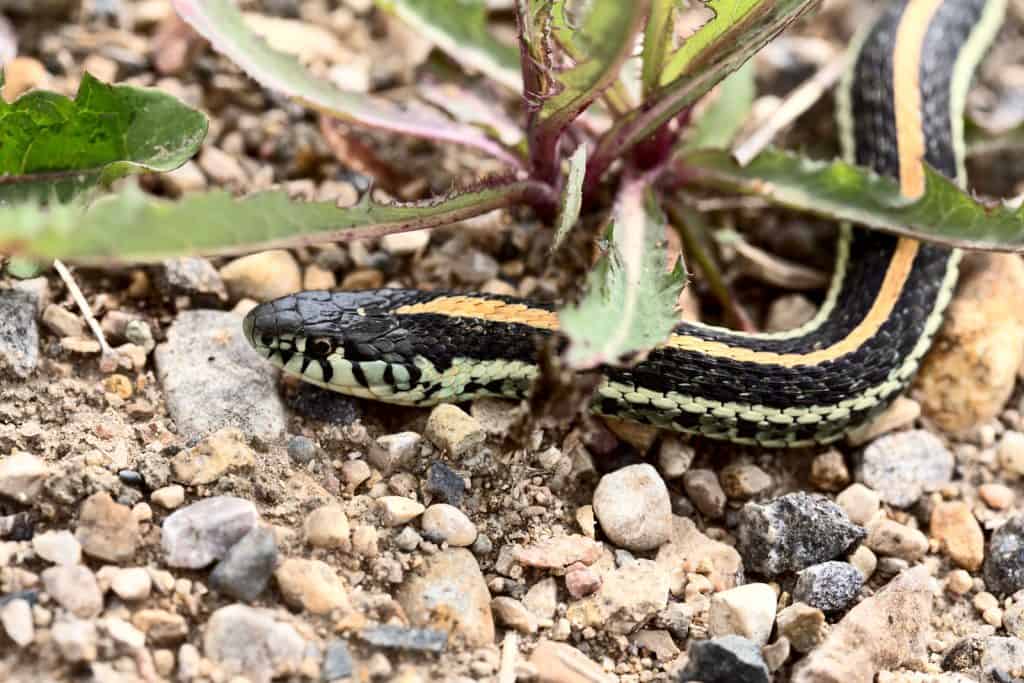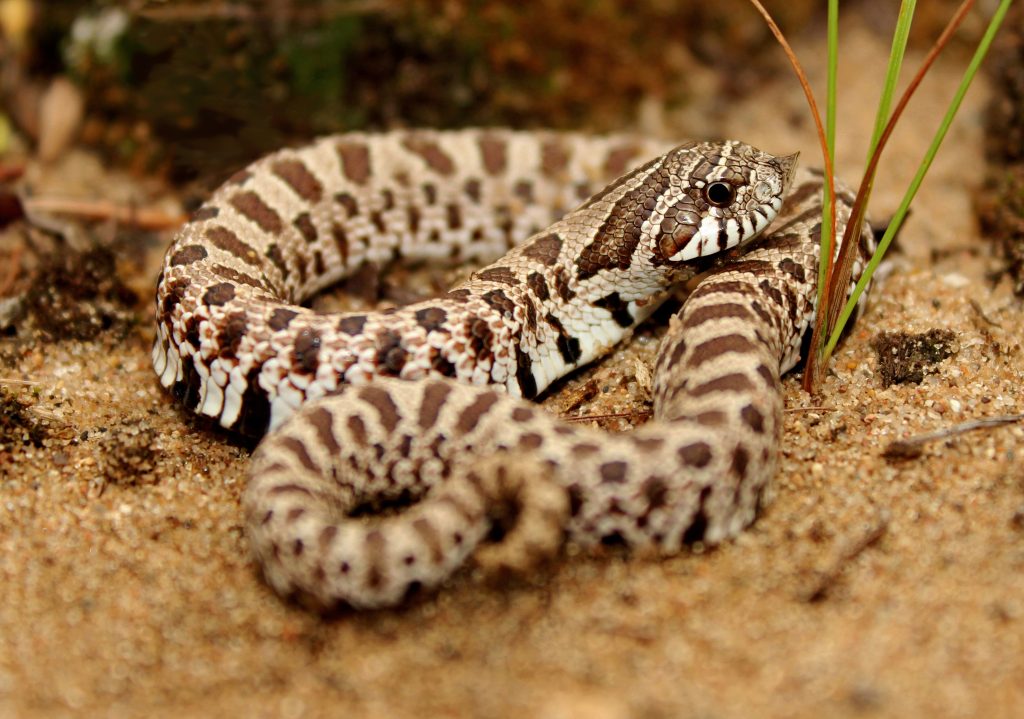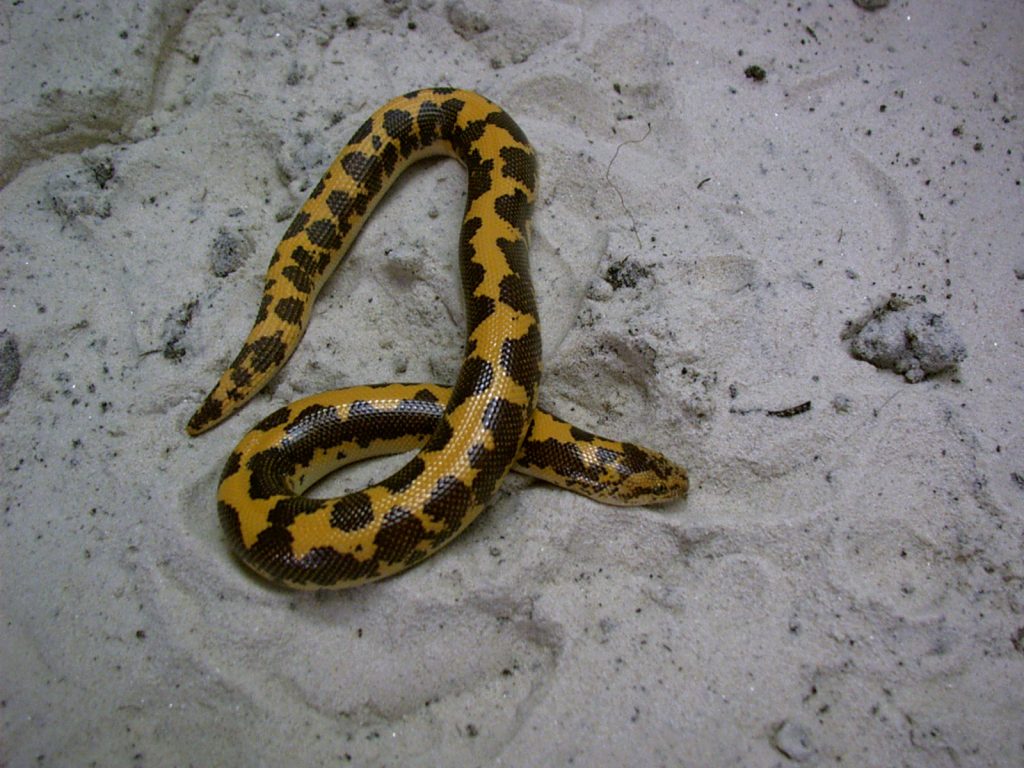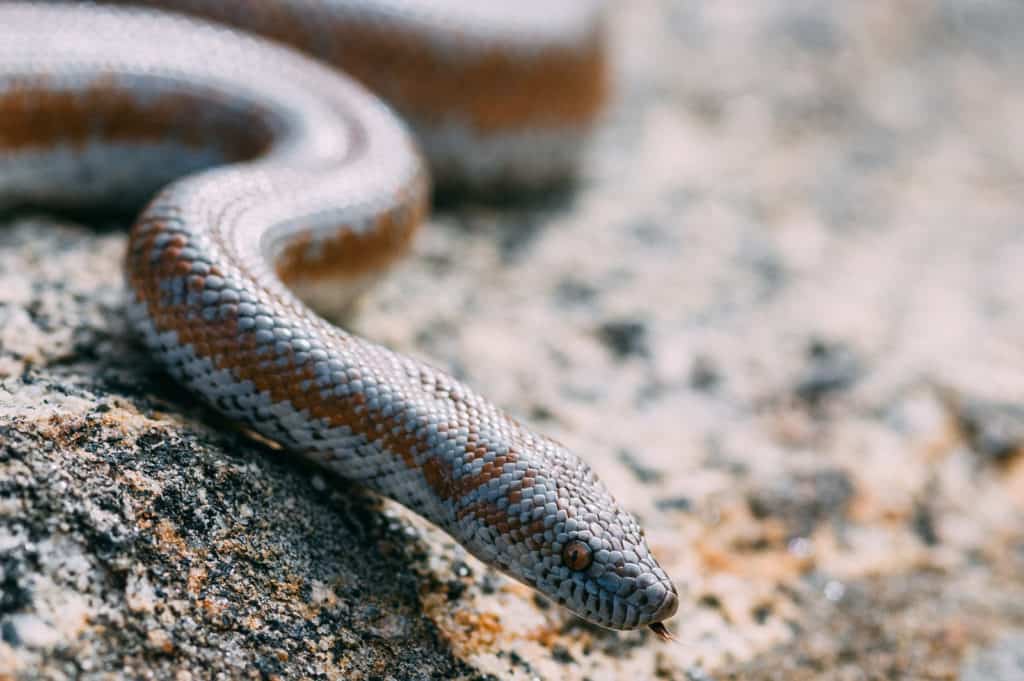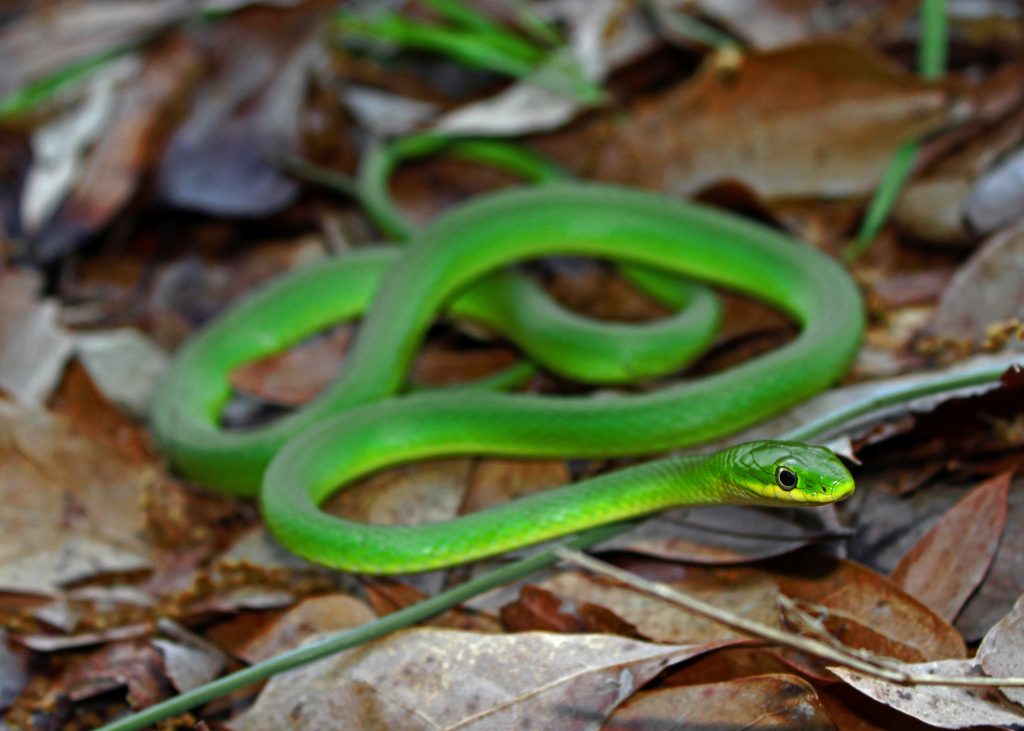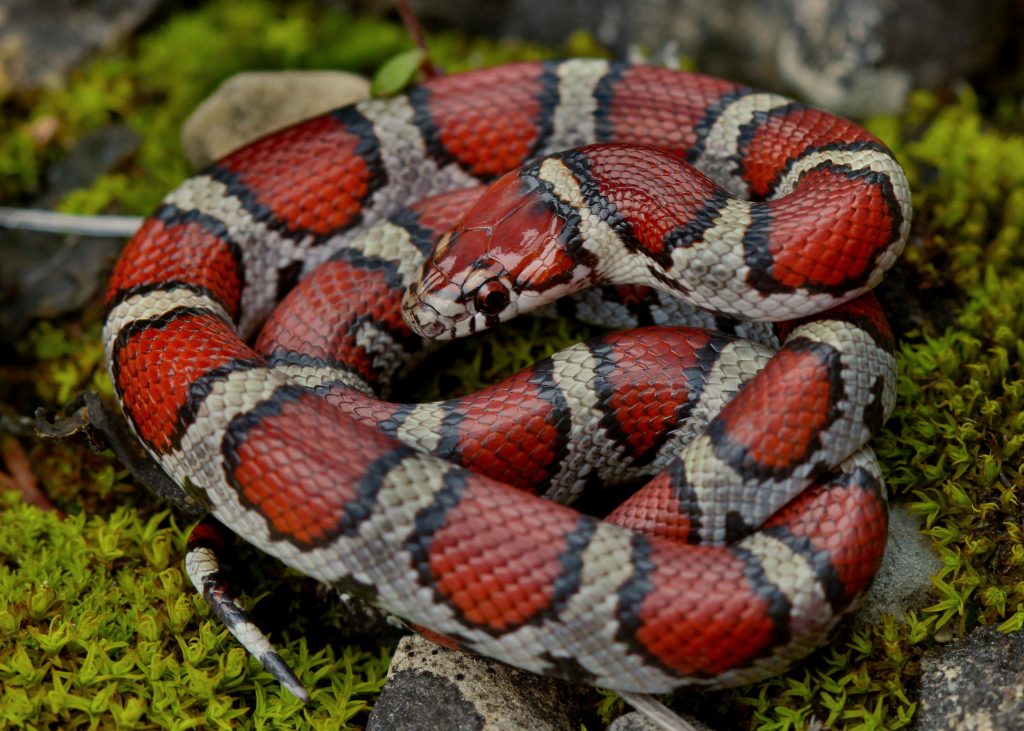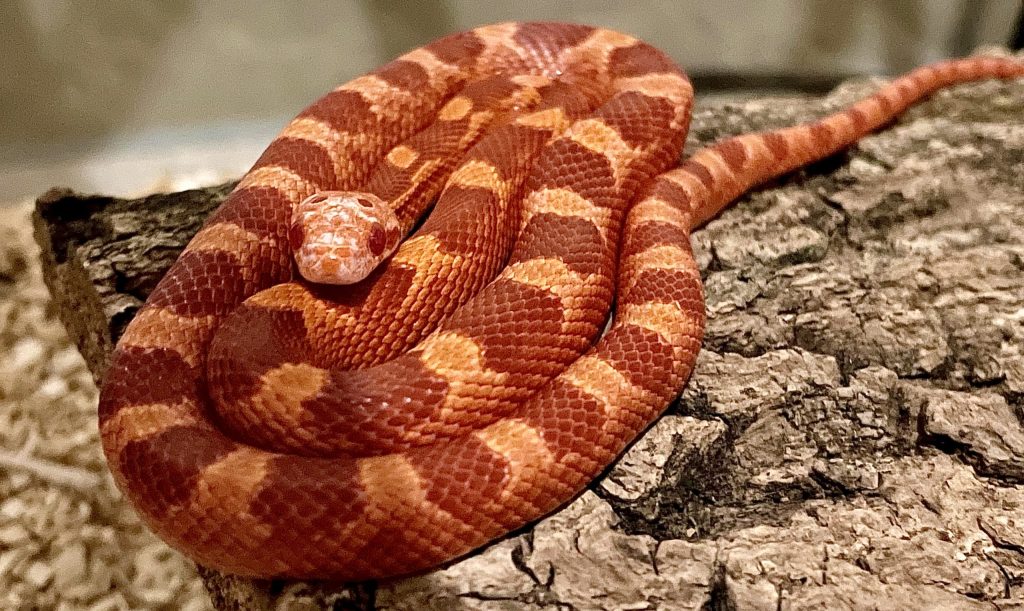Ever wondered if there’s an ideal pet snake that won’t grow into a giant, demanding more space and care? Well, there certainly is! The world of reptiles offers an array of smaller snake species tailor-made for your living space and your fascination. These petite serpents bring the best of both worlds – captivating aesthetics and manageable sizes. And the cherry on top? Most of these smaller wonders are great for beginners, too! But remember, while some snakes, like the Barbados thread snake, are fascinatingly tiny, they may not always be ideal pets.
Some of the top snakes that not only stay small but also make excellent pets include:
- Ringneck Snake
- Western Hognose
- Sand Boa
- Rosy Boa
- Garter Snake
- California Green Snake
So, if you’re curious about which snakes stay pocket-sized and are considering one as your next pet, read on!
The Best Small Pet Snakes:
- Barbados Threadsnake
- Bimini Blindsnake
- Worm Snake
- Ringneck Snake
- Smooth Green Snake
- Scarlet Kingsnake
- Anthill Python
- Garter Snake
- Western Hognose
- Kenyan Sand Boa
- Rosy Boa
- Rough Green Snake
- California Kingsnake
- Milk Snakes
- Corn Snakes
1. Barbados Threadsnake
The Barbados Threadsnake is the smallest snake species in the world. It’s found on Caribbean Islands like Barbados, Antigua, and Barbuda. Interestingly, people only discovered it in 2008. Before that, many mistook it for another species. Because of its worm-like look and tiny head, you might not even realize it’s a snake. They average about 4.1 inches in length and can weigh as little as 0.6g. (To put that in perspective, that’s 10 times lighter than a pencil!) Newborns are even smaller at just 0.4 inches.
These little snakes can live up to 10 years. They don’t eat like other snakes. Their size means they mostly eat ant and termite eggs. Though they’re gentle, they’re not common pets. Because of their delicate nature and specific diet. If you’re thinking of small snakes, remember the Barbados Threadsnake. However, they might not be the perfect pet for everyone.
2. Bimini Blindsnake
The Bimini Blind Snake, sometimes called the Brahminy Blind Snake, looks like an earthworm. (It’s easy to get them mixed up.) It originally came from Africa but can now be found in the Americas. You might notice its shiny body, which doesn’t have the usual scales you see on other snakes. Unlike the smaller Barbados thread snake, people sometimes keep the Bimini type as a pet. But, if you’re thinking of getting one, remember: they like to stay hidden underground. They get the name “blind” because they have tiny eyes that almost don’t work.
Most of these snakes are about 2 to 4 inches long. Some can grow up to 6.5 inches. They don’t weigh much – just about 0.5 to 1 gram. Even though they’re not very active, their small size makes them popular with reptile lovers. But, if you want a pet snake you can see and play with often, this might not be the best choice.
3. Worm Snake
The Worm Snake is a small reptile that resembles an earthworm. They’re about 7.5 to 13 inches long. With dark colors on top and pink below, they’re quite distinct. They originated from the U.S. There are two main types: darker Western and Eastern. Most of their diet consists of earthworms and soft insects. If you were to observe them, you’d often find them burrowing in the soil or tucked away under leaves and logs. For those thinking of keeping one, you’ll need a setup like a 10-gallon tank filled with soil and spots for them to hide.
Managing the right warmth and light is crucial. While they don’t bite, they’re quite timid and don’t like being handled too much. And, if they feel you’re a threat, they might prick with their tail spine or emit a defensive odor. For some, they might be a unique pet choice. But, from my perspective, they need specific care and aren’t the best for everyone, especially if you’re new to reptiles.
4. Ringneck Snake
The Ringneck snake is easily recognizable by its distinctive orange or yellow neckband around the neck. This small snake is usually between 10-15 inches long. Some people mistake them for earthworms or young snakes because of their size and color. Given their size, small spaces suit them best. They love to hide but don’t mind being handled occasionally.
Regarding food, they prefer smaller creatures, mainly tiny invertebrates and worms. (This makes feeding them slightly different from other snakes that eat frozen rodents.) While they’re certainly eye-catching, if you’re considering one as a pet, know they need specific care. In my view, they’re both charming and a bit more demanding as pets.
5. Smooth Green Snake
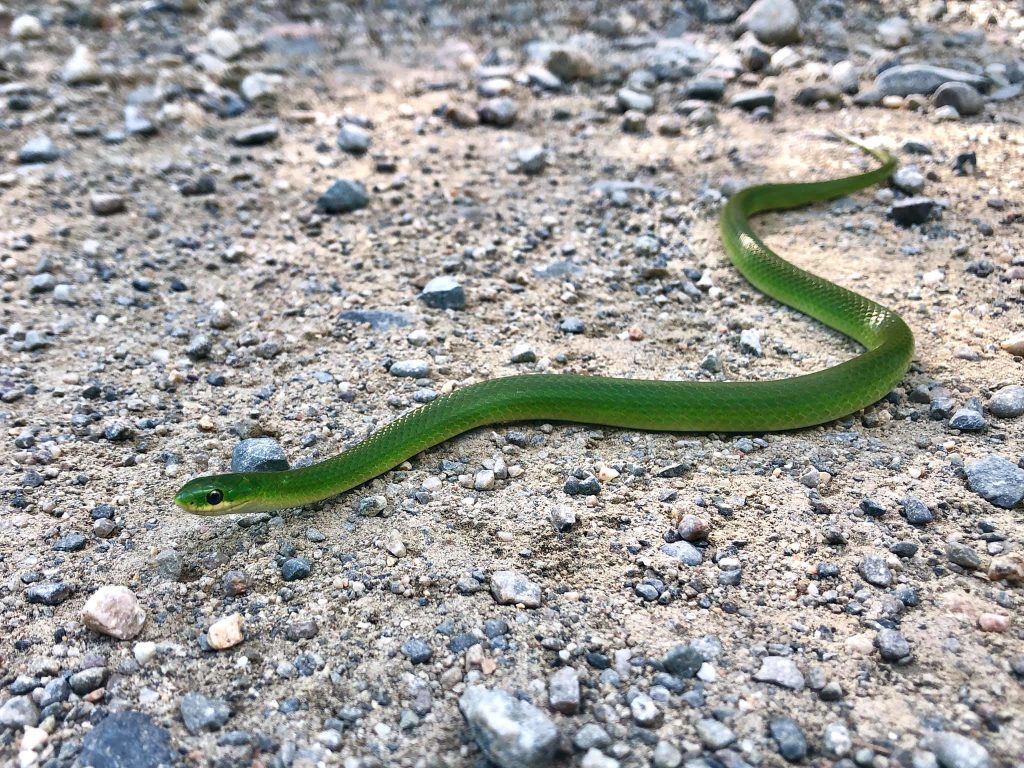
The Smooth Green Snake is known for its bright green color. It’s found in places ranging from the U.S. to Canada and even Mexico. They typically measure between 12 to 26 inches, which is medium-sized for a snake. Interestingly, about half its length comes from its tail, giving it a long and slender appearance.
When considering it as a pet, many people are drawn to its calm nature. But, if you’re one of them, be aware of its sometimes tricky eating habits and the specific care it might need. Fully grown, they weigh around 15.3 to 19.5 g but start as small as 1.1g when young. They’re beautiful, but they might demand more attention as pets.
6. Scarlet Kingsnake
The Scarlet Kingsnake is native to the southeastern and eastern U.S. Its colors are red, black, and yellow. This pattern makes it look like the venomous coral snake. But it’s harmless. And interestingly, it’s the smallest member of the Kingsnake family.
Adults are usually 14-20 inches long. The largest one recorded is 29.1 inches. Newborns start at just 3 inches. But they grow quickly. You’ll notice their weight is around 1270 g (2.77 lbs.) when fully mature.
These snakes have big appetites. They even eat other snakes. Their size and temperament make them good pets. Many beginners choose them as their first reptile. While their colors might be intimidating, their care isn’t. So you can appreciate their beauty without any fuss.
7. Anthill Python
The Anthill Python is also known as the Pygmy Python. It’s the smallest python species. Native to northwest Western Australia, it also lives on nearby islands. These snakes love anthills and termite mounds. That’s why they’re named “Anthill” pythons.
Their color is red-brown. And they have leopard-like spots. Adults are typically 20 inches long. Hatchlings start at 8 inches. But don’t be fooled by their size. Their build makes them heavier than you’d think. Precisely, they weigh between 200-220g.
If you’re thinking of pets, consider these pythons. Yet, always remember their specific dietary and habitat needs. After all, they are still pythons. And understanding their requirements will make for a happier snake.
8. Garter Snake
The Common Garter Snake is native to the U.S. Their size varies. On average, they’re 18-26 inches long. But some can reach 42 inches. Their distinctive appearance can differ due to the multiple species within their genus. For example, the Coast Garter Snake has a red color with black spots. And there’s a cream stripe down its back.
These snakes do have venom. But for humans, It mainly causes pain and swelling. They eat a range of foods, from mice to fish. If they eat fish, their waste smells stronger. Garter snakes have a unique mating habit. They form “mating balls” with many snakes involved. If you’re a beginner, handling them might be challenging because they need slightly higher humidity. Many newbies struggle a bit. Yet, with the right care, they can be great pets. So, consider them as an option.
9. Western Hognose
The Western Hognose is a North American snake. With its upturned snout, it looks a bit like a shovel. They average between 15-20 inches in length. Females can reach 3 feet. And interestingly, males are usually smaller than females. Plus, they can be quite hefty, mostly weighing between 60-120g.
Their unique patterns resemble those of a rattlesnake, consisting of stripes and dots against a contrasting brown-tan backdrop. In the wild, they love eating toads and amphibians. But in captivity, they can switch to a diet of mice. When they sense danger, they start “playing dead.” And release a musky odor as part of the act. Their calm nature and dramatic defense are both entertaining and beginner-friendly.
10. Kenyan Sand Boa
The Kenyan Sand Boa originated from Northern Africa. A compact snake by nature, it’s a hit among enthusiasts. Males average between 15 inches in length. While females are a tad larger, ranging between 26 and 32 inches, their appearance is distinct. They look like oversized worms.
Their color – a rich, deep brown. And it’s adorned with lighter patches. Being natural burrowers, they have a preference. They lean towards substrates like coconut mulch and calcium sand.
When it comes to care, there are specifics. They need high basking temperatures. Gentle handling is key, especially since they can be a bit jumpy. But here’s the thing: these boas have a temperament akin to ball pythons. Plus, their care isn’t overly demanding.
Their unique features make them stand out. Their subtle heads, chubby tails, and love for burrowing. All these make them a fascinating pick for anyone wanting a unique yet docile snake.
11. Rosy Boa
The Rosy Boa is native to California, Arizona, and Mexico. It’s known for its tri-colored stripes. They have shades like orange, brown, and black. Their lifespan varies between 15-30 years. Regarding size, hatchlings start from 10 inches, and adults range from 22–35 inches (2-3 feet).
This snake has a thick body. Yet, what truly distinguishes it is its calm temperament. There’s something special about its belly: a salmon-pink hue, especially in the Californian and Baja Mexican types.
Providing the right habitat is key. You need to monitor both temperature and humidity closely. To keep them healthy and thriving. When they reach 30 inches, they usually weigh around 400g. That’s notably heavy for their length.
They have interesting behaviors. They love both climbing and burrowing. And if I might add, their peaceful nature combined with these traits makes the Rosy Boa a top pick, whether you’re a beginner or a seasoned snake lover.
12. Rough Green Snake
The Rough Green Snake is a vibrant creature. It boasts a brilliant green shade. You’ll notice its slim, whip-like body. Interestingly, it’s longer than the Smooth Green Snake. Their adult size is about 14-33 inches, while the maximum recorded length is 46 inches.
When they hatch, they’re just 7 inches long. So, their growth is pretty impressive. Now, even with their length, they’re not heavy. Males typically weigh around 16g. Females about 26g.
Handling them is a breeze. Why? Because they’re so slender. And compared to the bulkier species like Rosy Boa, they’re a different experience. Given their docile nature and manageable size, the Rough Green Snake is ideal for budding snake enthusiasts.
13. California Kingsnake
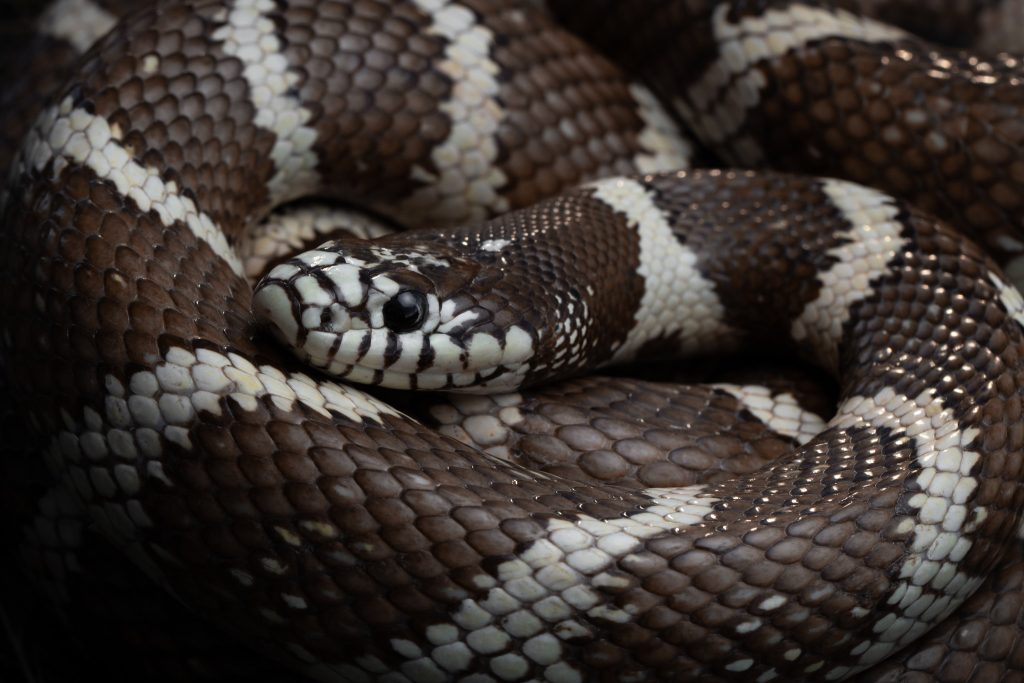
The California Kingsnake is a popular reptile. It’s closely related to the Scarlet Kingsnake. You’ll find it’s often chosen by snake lovers, mainly for its manageable size. Its colors and patterns vary a lot. Because it has many subspecies. The most common wild type displays deep brown with cream or tan crossbands.
Breeders have further expanded its color palette by introducing various morphs. It’s worth noting that these snakes are strong constrictors. They are more robust than most of their size. This strength stems from their unique diet: they eat other reptiles.
Now, about their size. They generally measure 30-40 inches (2.5-3.5 feet). However, some can reach up to six feet. When they’re born, they measure between 8-13 inches. And while they may be long, they aren’t heavy. A mature California Kingsnake weighs between 3.3 pounds (1.5 kilograms).
If you’re considering one as a pet, I’d say go for it. Their slender form and mild temperament make them ideal, especially if you’re starting.
14. Milk Snakes
Milk snakes have vibrant patterns—particularly red, black, and yellow bands. You might confuse them with the toxic coral snake. But they’re harmless. Their slender build often makes them look smaller than they are. Their size ranges from 20-60 inches.
As a member of the kingsnake family, various subspecies exist. For instance, the Sinaloan and Pueblan milksnakes. Each subspecies has its own care needs and appearance. Many enthusiasts, especially beginners, love them for their mild nature and diverse patterns.
15. Corn Snakes
Corn snakes are native to the southeastern U.S. and known for their bright colors. They have various morphs. But you might notice their main shade is a vivid orange-red. And, naturally, they’re accented with deeper red patterns.
Their length is typically between 2 to 6 feet. They averagely weigh around 1-3 pounds (454-1361 grams). Yet, weight can change depending on care and diet.
Young corn snakes can be a bit skittish. With time, they become calm. This mellow nature makes them great pets. Especially for beginners, they’re forgiving. However, some states, like Georgia, restrict ownership to protect wild populations.
Why Might a Small Pet Snake Be Right for You?
Small snakes are pretty easy to care for, especially when you compare them against the big ones. Imagine a small room – these snakes fit perfectly because they don’t occupy much space. Small snakes might be the one if you’re thinking of a fuss-free pet! They’re independent, do not need to eat or drink daily, and are comfortable in tight spots.
However, the best part might be the safety aspect. With smaller snakes, you’re looking at fewer scares because they’re not as aggressive as the big ones – which can sometimes be quite fierce or squeeze hard. And for those just starting out with snakes, you’re in luck! They’re super easy snakes to handle, which is a big plus for newbies.
Pros & Cons of Keeping Small Pet Snakes
Keeping small snakes as pets can be an exciting and rewarding experience, but it also comes with its own set of challenges and responsibilities. Let’s break down the pros and cons of having small pet snakes:
Pros:
- Size: Little snakes – they’re a breeze! They don’t need a mansion. Just a tiny space works. If you’re new to the snake world, starting small is a smart move.
- Maintenance: They’re sort of like low-maintenance friends. Clean their space occasionally, feed them less, and you’re good to go.
- Long Lifespan: Some tiny slithering companions can be with you for years.
- Cost: Smaller snakes are usually cheaper to buy and maintain. Everything from their home to their food – it’s cheaper than the larger ones.
- Allergy-Friendly: If pets make you sneeze, here’s good news. Snakes don’t have fur – so no allergies!
Cons:
- Specialized Care: Like all reptiles, small snakes require a specialized environment – think of a place with just the right temperature and humidity. And, well, that can be a bit of a task.
- Limited Interaction and Hiding Behavior: Some are super shy. They like hiding, so you might be disappointed if you’re expecting playtime.
- Visibility and Monitoring: They’re so small – spotting if they’re sick or sad can be challenging.
- Feeding Time: Snakes are carnivores whose diet mainly consists of rodents. It can be a bit unsettling for some individuals.
- Escape Artists: Snakes, regardless of their size, can be adept at escaping their enclosures if they’re not securely fastened, which could be stressful for the owner. And trust me – finding a runaway snake isn’t fun.
Take Care!
So, you’re thinking about getting a small pet snake? Awesome! Picking one out is super fun, but remember, it’s not just about how they look. As we’ve seen, little snakes come with cool perks but also some challenges. Having one in your home is like bringing in a mini dose of nature’s magic – their colors, the way they move, everything! But, and this is important, even though they’re small – they need love and proper care.
We’d love to hear your thoughts! Drop a comment below with your experiences or opinions on these small pet snakes. And if you found this article insightful, don’t hesitate to share it with fellow reptile enthusiasts! 🐍

